A Study on the Pore Structure and NMR Fractal Characteristics of Continental Shale in the Funing Formation of the Gaoyou Sag, Subei Basin
Abstract
:1. Introduction
2. Geological Setting and Samples
3. Methods
3.1. TOC, Mineralogical Analysis, and SEM
3.2. NMR Experiment
3.3. Fractal Dimension
4. Result
4.1. TOC and Mineral Composition
4.2. Pore Type and Morphology
4.2.1. Organic Matter Pores
4.2.2. Intergranular Pores
4.2.3. Intragranular Pores
4.3. NMR Experiment and Its Fractal Characteristics
4.3.1. NMR Experimental Results and Physical Properties
4.3.2. NMR Fractal Dimension
5. Discussion
5.1. Relationship between the NMR Fractal Dimension and Organic Geochemical Characteristics
5.2. Relationship between the NMR Fractal Dimension and Mineral Composition
5.3. Relationship between the NMR Fractal Dimension and Physical Parameters
6. Conclusions
- (1)
- The Funing Formation shale is presently considered to be in a mature stage, as evidenced by the majority of samples displaying a total organic carbon (TOC) content surpassing 1%. This suggests the presence of favorable organic geochemical conditions. The shale samples from the Funing Formation exhibit a dominant mineral composition, with quartz comprising an average of 25.53% and dolomite comprising an average of 24.23%. Clay minerals follow closely, with an average composition of 20.77%, while feldspar constitutes an average of 13.80%. Nevertheless, it is worth noting that there is no single mineral that demonstrates a distinct dominance, as each average content remains below 40%.
- (2)
- The primary pore classifications observed in the Funing Formation shale within the Gaoyou Sag consist of inorganic matrix pores. These pores encompass dissolution pores, intergranular pores formed by clay minerals, and a limited quantity of intergranular pores associated with pyrite. The range of the pore-size distribution is extensive, spanning from a few nanometers to hundreds of nanometers, with a minority extending into the micron range. On average, the pore size measures in the tens of nanometers.
- (3)
- The Funing formation’s NMR fractal dimension displays a notable two-segment configuration, wherein the fractal dimension DMin, which characterizes the pore structure of bound fluid, spans 0.5795 to 1.3813 (with a mean value of 0.8110). Furthermore, the fractal dimension DMax, which serves as an indicator of the pore structure of fluid that can be displaced, exhibits a range of values from 2.9592 to 2.9793, with an average value of 2.9651.
- (4)
- The organic geochemical characteristics and mineral composition of shale exert varying degrees of influence on the NMR fractal dimensions characterizing the two pore structures. Specifically, TOC, quartz, calcite, illite–smectite, illite, and chlorite impact DMin, with all except calcite and illite–smectite showing negative correlations. Organic matter content and mineral composition play a significant role in controlling the fractal dimension.
- (5)
- The evaluation of reservoir performance relies heavily on the assessment of porosity and permeability, which are considered to be vital parameters. There exists a noteworthy correlation between the physical parameters and the fractal dimensions of both bound-fluid pores and movable-fluid pores. This implies that the utilization of NMR fractal dimensions can be advantageous in assessing physical properties, thereby enhancing the characterization of reservoirs.
Author Contributions
Funding
Institutional Review Board Statement
Informed Consent Statement
Data Availability Statement
Acknowledgments
Conflicts of Interest
References
- Zou, C.; Ma, F.; Pan, S.; Zhang, X.; Wu, S.; Fu, G.; Wang, H.; Yang, Z. Formation and distribution potential of global shale oil and the developments of continental shale oil theory and technology in China. Earth Sci. Front. 2023, 30, 128–142. [Google Scholar]
- Zhao, W.; Zhu, R.; Liu, W. Advances in theory and technology of non-marine shale oil exploration in China. Pet. Sci. Bull. 2023, 8, 373–390. [Google Scholar]
- Jin, Z.J.; Zhu, R.K.; Liang, X.P.; Shen, Y.Q. Several issues worthy of attention in current lacustrine shale oil exploration and development. Pet. Explor. Dev. 2021, 48, 1471–1484. [Google Scholar]
- Ma, Y.; Cai, X.; Zhao, P.; Hu, Z.; Liu, H.; Gao, B.; Wang, W.; Li, Z.; Zhang, Z. Geological characteristics and exploration practices of continental shale oil in China. Acta Geol. Sin. 2022, 96, 155–171. [Google Scholar]
- Duan, H.; Liu, S.; Fu, Q. Characteristics and sedimentary environment of organic-rich shale in the second member of Paleogene Funing Formation, Subei Basin. Pet. Geol. Exp. 2020, 42, 612–617. [Google Scholar]
- Yun, L.; He, X.; Hua, C.; Zan, L. Accumulation characteristics and resource potential of Paleogene continental shale oil in Qintong sag of Subei Basin. Acta Pet. Sin. 2023, 44, 176–187. [Google Scholar]
- Li, P.; Gong, H.J.; Jiang, Z.X.; Zhang, F.; Liang, Z.K.; Wang, Z.P.; Wu, Y.H.; Shao, X.D. Characteristics and Influencing Factors of Multi-Scale Pore Structure Heterogeneity of Lacustrine Shale in the Gaoyou Sag, Eastern China. Minerals 2023, 13, 359. [Google Scholar] [CrossRef]
- Zhu, R.; Wu, S.; Su, L.; Cui, J.; Mao, Z.; Zhang, X. Problems and future works of porous texture characterization of tight reservoirs in China. Acta Pet. Sin. 2016, 37, 1323–1336. [Google Scholar]
- Jiang, Z.; Tang, X.; Li, Z.; Huang, H.; Yang, P.; Yang, X.; Li, W.; Hao, J. The whole-aperture pore structure characteristics and its effect on gas content of the Longmaxi Formation shale in the southeastern Sichuan basin. Earth Sci. Front. 2016, 23, 126–134. [Google Scholar]
- Lu, S.; Li, J.; Zhang, P.; Xue, H.; Wang, G.; Zhang, J.; Liu, H.; Li, Z. Classification of microscopic pore-throats and the grading evaluation on shale oil reservoirs. Pet. Explor. Dev. 2018, 45, 436–444. [Google Scholar]
- Zhao, W.Z.; Hu, S.Y.; Hou, L.H. Connotation and strategic role of in-situ conversion processing of shale oil underground in the onshore China. Pet. Explor. Dev. 2018, 45, 563–572. [Google Scholar] [CrossRef]
- Hu, Q.H.; Zhang, Y.X.; Meng, X.H.; Li, Z.; Xie, Z.H.; Li, M.W. Characterization of micro-nano pore networks in shale oil reservoirs of Paleogene Shahejie Formation in Dongying Sag of Bohai Bay Basin, East China. Pet. Explor. Dev. 2017, 44, 720–730. [Google Scholar] [CrossRef]
- Alemdag, S.; Gurocak, Z.; Cevik, A.; Cabalar, A.F.; Gokceoglu, C. Modeling deformation modulus of a stratified sedimentary rock mass using neural network, fuzzy inference and genetic programming. Eng. Geol. 2016, 203, 70–82. [Google Scholar] [CrossRef]
- Yang, R.; He, S.; Yi, J.Z.; Hu, Q.H. Nano-scale pore structure and fractal dimension of organic-rich Wufeng-Longmaxi shale from Jiaoshiba area, Sichuan Basin: Investigations using FE-SEM, gas adsorption and helium pycnometry. Mar. Pet. Geol. 2016, 70, 27–45. [Google Scholar] [CrossRef]
- Clarkson, C.R.; Solano, N.; Bustin, R.M.; Bustin, A.M.M.; Chalmers, G.R.L.; He, L.; Melnichenko, Y.B.; Radlinski, A.P.; Blach, T.P. Pore structure characterization of North American shale gas reservoirs using USANS/SANS, gas adsorption, and mercury intrusion. Fuel 2013, 103, 606–616. [Google Scholar] [CrossRef]
- Wang, Z.; Jiang, Y.; Fu, Y.; Lei, Z.; Xu, C.; Yuan, J.; Wen, R.; Wang, Z.; Gu, Y.; Yin, X. Characterization of Pore Structure and Heterogeneity of Shale Reservoir from Wufeng Formation-Sublayers Lon g-11 in Western Chongqing Based on Nuclear Magnetic Resonance. Earth Sci. 2022, 47, 490–504. [Google Scholar]
- Ma, Y.; Zhong, N.; Huang, X.; Guo, Z.; Yao, L. The application of focused ion beam scanning electron microscope (FIB-SEM) to the nanometer-sized pores in shales. J. Chin. Electron. Microsc. Soc. 2014, 33, 251–256. [Google Scholar]
- Yao, Y.; Liu, D. Petrophysical properties and fluids transportation in gas shale: A NMR relaxation spectrum analysis method. J. China Coal Soc. 2018, 43, 181–189. [Google Scholar]
- Zhang, L.; Xu, Y.; Sun, M.; Jiang, S.; Zhang, Y.; Wu, C.; Zhang, J.; Liang, X.; Wang, G. The Structure and Evolution of Closed Pores in Shale Determined by Small Angle Neutron Scattering. Acta Sedimentol. Sin. 2021, 39, 310–323. [Google Scholar]
- Yan, J.-P.; He, X.; Geng, B.; Hu, Q.-H.; Feng, C.-Z.; Kou, X.-P.; Li, X.-W. Nuclear magnetic resonance T2 spectrum: Multifractal characteristics and pore structure evaluation. Appl. Geophys. 2017, 14, 205–215. [Google Scholar] [CrossRef]
- Liang, Z.; Li, Z.; Li, L.; Jiang, Z.; Liu, D.; Gao, F.; Liu, X.; Xiao, L.; Yang, Y. Relationship between multifractal characteristics of pore size and lithofacies of shale of Shahezi Formation in Changling fault depression, Songliao Basin. Lithol. Reserv. 2020, 32, 22–35. [Google Scholar]
- Li, Z.; Wang, W.; Wang, X.; Bai, Y.; Qin, D.; Zhao, Y. Study on Fractal Characteristics of Micro-Nano Pore Structure of Shale. J. Eng. Geol. 2018, 26, 494–503. [Google Scholar]
- GB/T 19145-2022; Determination for Total Organic Carbon in Sedimentary Rock. China National Standards: Shenzhen, China, 2022.
- Xiao, X. Organic Petrology and Its Application in Oil and Gas Evaluation. Adv. Earth Sci. 1992, 7, 39–44. [Google Scholar]
- SY/T 5163-2018; X-ray Diffraction Analysis Method for Clay Minerals and Common Non Clay Minerals in Sedimentary Rocks. China National Energy Administration: Beijing, China, 2018; p. 39.
- Nefeslioglu, H.A. Evaluation of geo-mechanical properties of very weak and weak rock materials by using non-destructive techniques: Ultrasonic pulse velocity measurements and reflectance spectroscopy. Eng. Geol. 2013, 160, 8–20. [Google Scholar] [CrossRef]
- Lai, J.; Wang, G.W. Fractal analysis of tight gas sandstones using high-pressure mercury intrusion techniques. J. Nat. Gas Sci. Eng. 2015, 24, 185–196. [Google Scholar] [CrossRef]
- Giri, A.; Tarafdar, S.; Gouze, P.; Dutta, T. Fractal pore structure of sedimentary rocks: Simulation in 2-d using a relaxed bidisperse ballistic deposition model. J. Appl. Geophys. 2012, 87, 40–45. [Google Scholar] [CrossRef]
- Qu, S.; Zhang, J. Fractal and fractal dimension and their application in geophysics. J. Xi’an Shiyou Univ. 1991, 6, 8–13. [Google Scholar]
- Liu, S.; Tang, S.; Huo, T.; Tan, F.; Liu, D.; Wang, J. Pore structure and fractal characteristics of the Upper Carboniferous shale, eastern Qaidam Basin. Nat. Gas Geosci. 2020, 31, 1069–1081. [Google Scholar]
- Zhang, C.; Chen, Z.; Zhang, Z.; Wang, B.; Zan, L. Fractal characteristics of reservoir rock pore structure based on NMR T2 distribution. J. Oil Gas Technol. 2007, 4, 6. [Google Scholar]
- Loucks, R.G.; Reed, R.M.; Ruppel, S.C.; Hammes, U. Spectrum of pore types and networks in mudrocks and a descriptive classification for matrix-related mudrock pores. AAPG Bull. 2012, 96, 1071–1098. [Google Scholar] [CrossRef]
- Liu, J.; Lai, X.; Yu, B.; Chen, X.; Duo, C. The Current Situation and Developing Tendency of the Study on Diagenesis. Pet. Geol. Exp. 2006, 28, 65–72,77. [Google Scholar]
- Qu, K.X.; Guo, S.B. Investigation of the Pore Structure of Tight Sandstone Based on Multifractal Analysis from NMR Measurement: A Case from the Lower Permian Taiyuan Formation in the Southern North China Basin. Energies 2020, 13, 4067. [Google Scholar] [CrossRef]
- Wang, F.Y.; Yang, K.; Cai, J.C. Fractal Characterization of Tight Oil Reservoir Pore Structure Using Nuclear Magnetic Resonance and Mercury Intrusion Porosimetry. Fractals 2018, 26, 1840017. [Google Scholar] [CrossRef]
- Tian, H.; Zhang, S.; Liu, S.; Zhang, H. Determination of organic-rich shale pore features by mercury injection and gas adsorption methods. Acta Pet. Sin. 2012, 33, 419–427. [Google Scholar]
- Zhang, P.; Huang, Y.; Zhang, J.; Liu, H.; Yang, J. Fractal characteristics of the Longtan formation transitional shale in northwest Guizhou. J. China Coal Soc. 2018, 43, 1580–1588. [Google Scholar]
- Ji, L.; Zhang, T.; Milliken, K.L.; Qu, J.; Zhang, X. Experimental investigation of main controls to methane adsorption in clay-rich rocks. Appl. Geochem. 2012, 27, 2533–2545. [Google Scholar] [CrossRef]
- Mohamed, A.M.O. The role of clay minerals in marly soils on its stability. Eng. Geol. 2000, 57, 193–203. [Google Scholar] [CrossRef]
- Chen, J.; Wu, W.; Wang, J.; Huang, X. Microscopic pore characteristics and influence factors analysis of shales in permian, yanlong area, southern north china basin. J. Geomech. 2017, 23, 829–837. [Google Scholar]
- Zhou, L.; Kang, Z.H. Fractal characterization of pores in shales using NMR: A case study from the Lower Cambrian Niutitang Formation in the Middle Yangtze Platform, Southwest China. J. Nat. Gas Sci. Eng. 2016, 35, 860–872. [Google Scholar] [CrossRef]

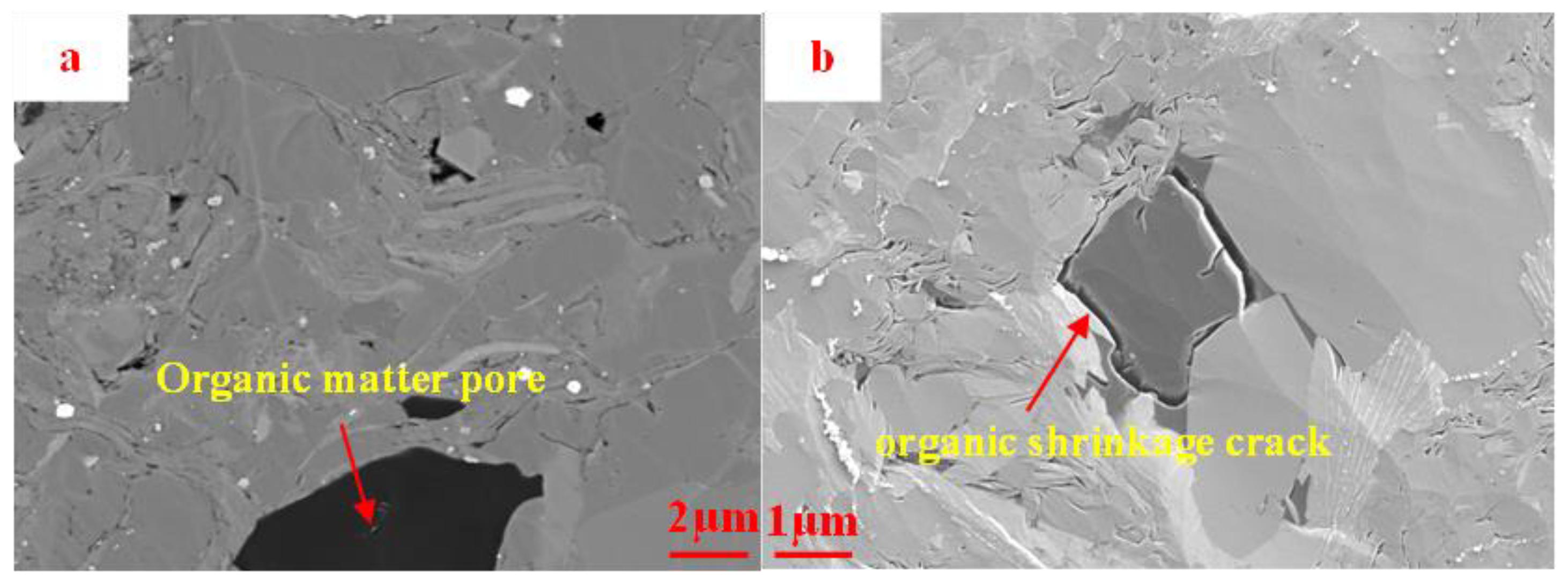



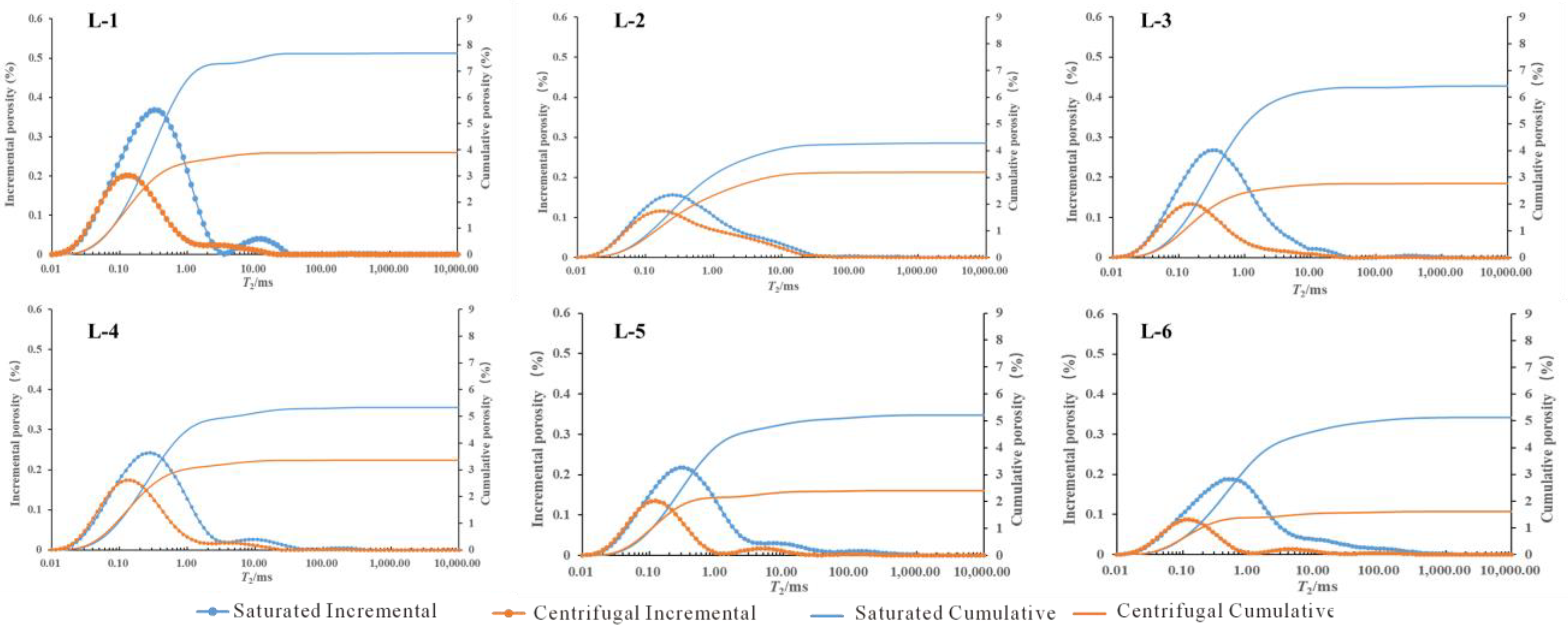
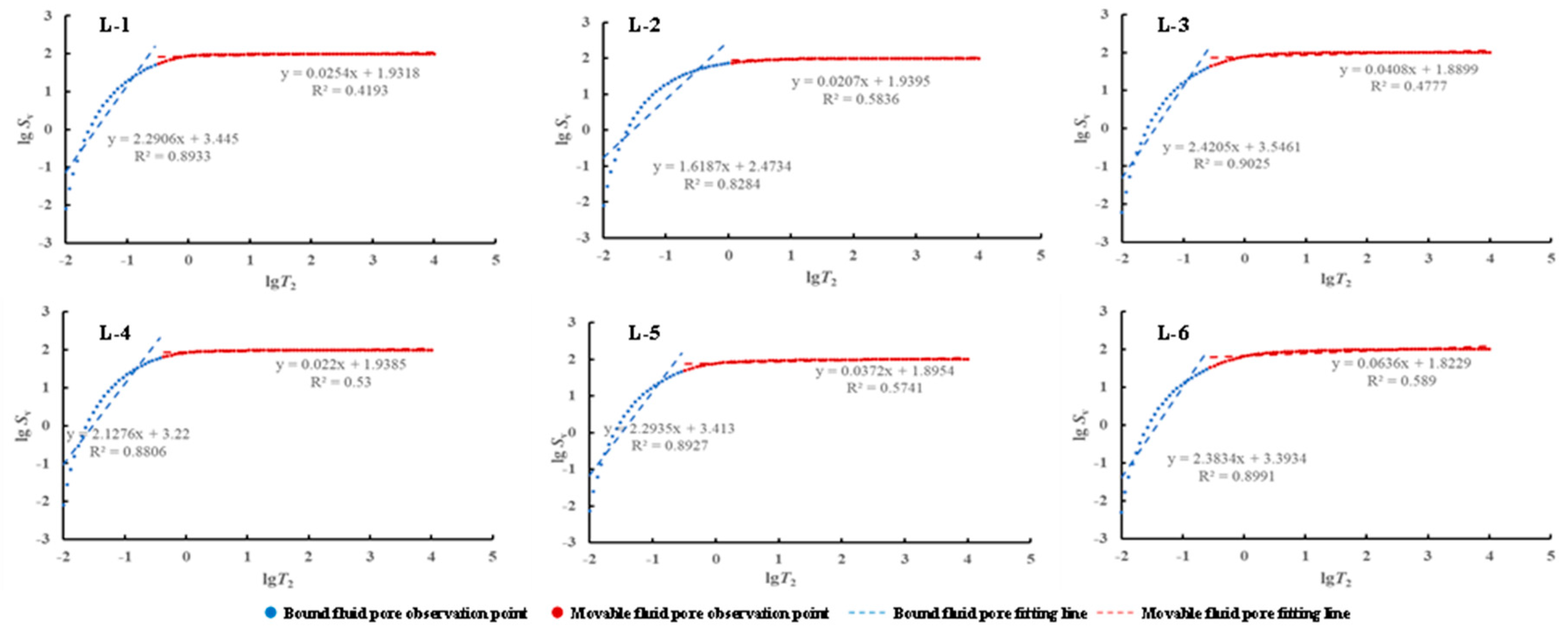
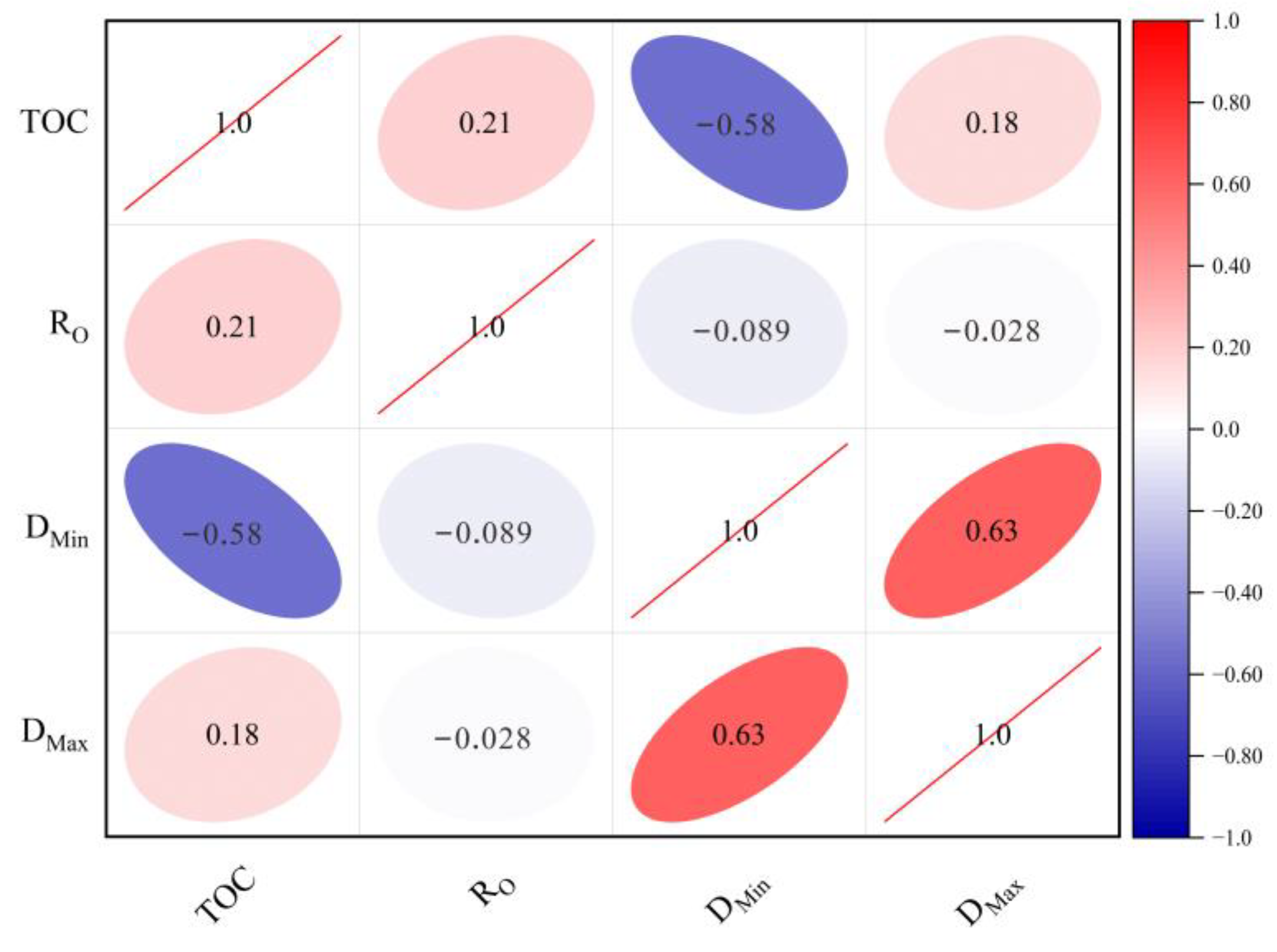
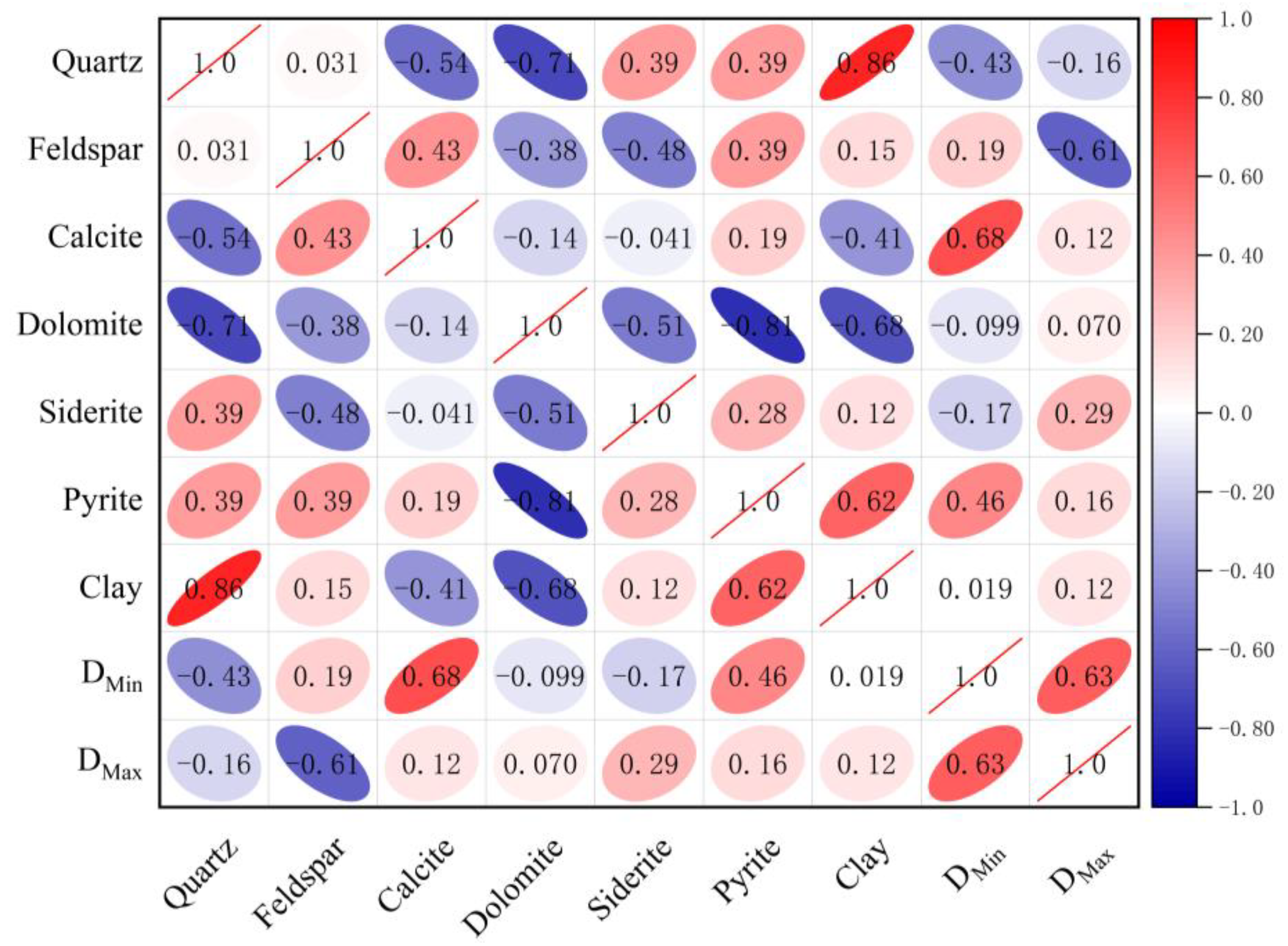


| Sample ID | Depth (m) | Quartz (wt.%) | Feldspar (wt.%) | Calcite (wt.%) | Dolomite (wt.%) | Siderite (wt.%) | Pyrite (wt.%) | Clay (wt.%) | TOC (wt.%) | RO/% |
|---|---|---|---|---|---|---|---|---|---|---|
| L-1 | 3460.2 | 30.1 | 2.5 | 8.8 | 2.8 | 30.6 | 2.8 | 22.4 | 1.813 | 0.9 |
| L-2 | 3656.15 | 20.8 | 22.3 | 15.2 | 16.7 | 0 | 3.7 | 21.3 | 0.554 | 0.89 |
| L-3 | 3694.92 | 22.7 | 6.9 | 3.7 | 48.1 | 0 | 1.4 | 17.2 | 1.426 | 0.86 |
| L-4 | 3717.6 | 20.2 | 2.8 | 10.6 | 51.8 | 0 | 0 | 14.6 | 1.031 | 0.91 |
| L-5 | 3704.06 | 34.7 | 17.9 | 4.1 | 7.9 | 0 | 2.7 | 32.7 | 1.106 | 0.88 |
| L-6 | 3680.01 | 24.7 | 30.4 | 12.7 | 18.1 | 0 | 1.7 | 16.4 | 0.734 | 0.81 |
| Sample ID | Total Porosity/% | Porosity of Movable Fluid/% | Bound Fluid Porosity/% | Permeability /mD |
|---|---|---|---|---|
| L-1 | 7.68 | 3.78 | 3.90 | 0.06777 |
| L-2 | 6.41 | 3.63 | 2.78 | 0.05983 |
| L-3 | 4.28 | 1.10 | 3.18 | 0.00083 |
| L-4 | 5.34 | 1.98 | 3.36 | 0.00586 |
| L-5 | 5.21 | 2.80 | 2.41 | 0.02072 |
| L-6 | 5.13 | 3.53 | 1.60 | 0.06981 |
| Sample ID | T2 < T2C | T2 > T2C | ||||
|---|---|---|---|---|---|---|
| NMR Regression Equation | DMin | R-Squared | NMR Regression Equation | DMax | R-Squared | |
| L-1 | y = 2.2906x + 3.445 | 0.7094 | 0.8933 | y = 0.0254x + 1.9318 | 2.9746 | 0.4193 |
| L-2 | y = 1.6187x + 2.4734 | 1.3813 | 0.8284 | y = 0.0207x + 1.9395 | 2.9793 | 0.5836 |
| L=3 | y = 2.4205x + 3.5461 | 0.5795 | 0.9025 | y = 0.0408x + 1.8899 | 2.9592 | 0.4777 |
| L-4 | y = 2.1276x + 3.22 | 0.8724 | 0.8806 | y = 0.022x + 1.9385 | 2.978 | 0.53 |
| L-5 | y = 2.2935x + 3.413 | 0.7065 | 0.8927 | y = 0.0372x + 1.8954 | 2.9628 | 0.5741 |
| L-6 | y = 2.3834x + 3.3934 | 0.6166 | 0.8991 | y = 0.0636x + 1.8229 | 2.9364 | 0.589 |
Disclaimer/Publisher’s Note: The statements, opinions and data contained in all publications are solely those of the individual author(s) and contributor(s) and not of MDPI and/or the editor(s). MDPI and/or the editor(s) disclaim responsibility for any injury to people or property resulting from any ideas, methods, instructions or products referred to in the content. |
© 2023 by the authors. Licensee MDPI, Basel, Switzerland. This article is an open access article distributed under the terms and conditions of the Creative Commons Attribution (CC BY) license (https://creativecommons.org/licenses/by/4.0/).
Share and Cite
Wang, Z.; Zhu, Y.; Jiang, Z.; Gong, H.; Yang, Y.; Wang, B.; Wang, X. A Study on the Pore Structure and NMR Fractal Characteristics of Continental Shale in the Funing Formation of the Gaoyou Sag, Subei Basin. Appl. Sci. 2023, 13, 12484. https://doi.org/10.3390/app132212484
Wang Z, Zhu Y, Jiang Z, Gong H, Yang Y, Wang B, Wang X. A Study on the Pore Structure and NMR Fractal Characteristics of Continental Shale in the Funing Formation of the Gaoyou Sag, Subei Basin. Applied Sciences. 2023; 13(22):12484. https://doi.org/10.3390/app132212484
Chicago/Turabian StyleWang, Zipeng, Yue Zhu, Zhenxue Jiang, Houjian Gong, Yu Yang, Bo Wang, and Xin Wang. 2023. "A Study on the Pore Structure and NMR Fractal Characteristics of Continental Shale in the Funing Formation of the Gaoyou Sag, Subei Basin" Applied Sciences 13, no. 22: 12484. https://doi.org/10.3390/app132212484





